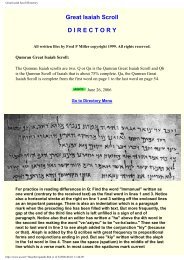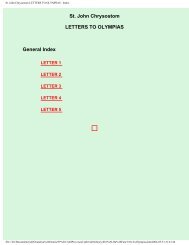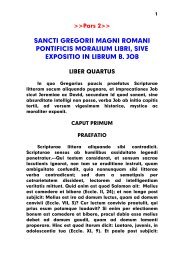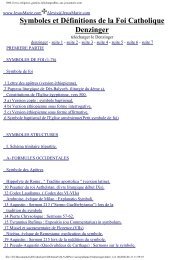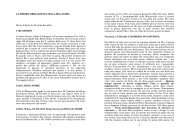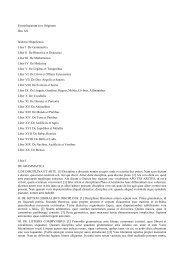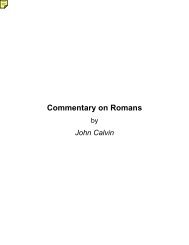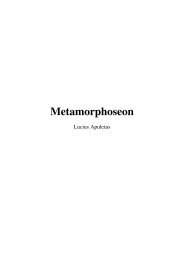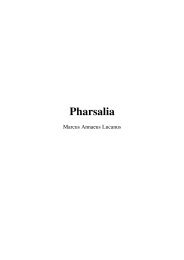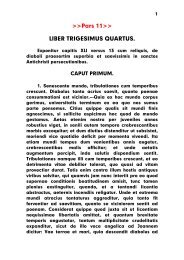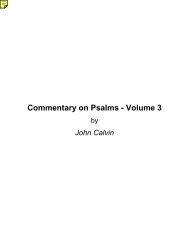The Dolorous Passion of Our Lord Jesus Christ. - documenta ...
The Dolorous Passion of Our Lord Jesus Christ. - documenta ...
The Dolorous Passion of Our Lord Jesus Christ. - documenta ...
Create successful ePaper yourself
Turn your PDF publications into a flip-book with our unique Google optimized e-Paper software.
<strong>The</strong> <strong>Dolorous</strong> <strong>Passion</strong> <strong>of</strong> <strong>Our</strong> <strong>Lord</strong> <strong>Jesus</strong> <strong>Christ</strong>.Anne Catherine EmmerichTO THE READERWHOEVER compares the following meditations with the short history <strong>of</strong> the Last Supper givenin the Gospel will discover some slight differences between them. An explanation should be given<strong>of</strong> this, although it can never be sufficiently impressed upon the reader that these writings have nopretensions whatever to add an iota to Sacred Scripture as interpreted by the Church.66Sister Emmerich saw the events <strong>of</strong> the Last Supper take place in the following order:—<strong>The</strong> PaschalLamb was immolated and prepared in the supper-room; our <strong>Lord</strong> held a discourse on thatoccasion—the guests were dressed as travellers, and ate, standing, the lamb and other food prescribedby the law—the cup <strong>of</strong> wine was twice presented to our <strong>Lord</strong>, but he did not drink <strong>of</strong> it the secondtime; distributing it to his Apostles with these words: I shall drink no more <strong>of</strong> the fruit <strong>of</strong> the vine,&c. <strong>The</strong>n they sat down; <strong>Jesus</strong> spoke <strong>of</strong> the traitor; Peter feared lest it should be himself; Judasreceived from our <strong>Lord</strong> the piece <strong>of</strong> bread dipped, which was the sign that it was he; preparationswere made for the washing <strong>of</strong> the feet; Peter strove against his feet being washed; then came theinstitution <strong>of</strong> the Holy Eucharist: Judas communicated, and afterwards left the apartment; the oilswere consecrated, and instructions given concerning them; Peter and the other Apostles receivedordination; our <strong>Lord</strong> made his final discourse; Peter protested that he would never abandon him;and then the Supper concluded. By adopting this order, it appears, at first, as though it were incontradiction to the passages <strong>of</strong> St. Matthew (xxxi. 29), and <strong>of</strong> St. Mark (xiv. 26), in which thewords: I will drink no more <strong>of</strong> the fruit <strong>of</strong> the vine, &c., come after the consecration, but in St. Luke,they come before. On the contrary, all that concerns the traitor Judas comes here, as in St. Matthewand St. Mark, before the consecration; whereas in St. Luke, it does not come till afterwards. St.John, who does not relate the history <strong>of</strong> the institution <strong>of</strong> the Holy Eucharist, gives us to understandthat Judas went out immediately after <strong>Jesus</strong> had given him the bread; but it appears most probable,from the accounts <strong>of</strong> the other Evangelists, that Judas received the Holy Communion under bothforms, and several <strong>of</strong> the fathers—St. Augustin, St. Gregory the Great, and St. Leo the Great—aswell as the tradition <strong>of</strong> the Catholic Church, tell us expressly that such was the case. Besides, werethe order in which St. John presents events taken literally, he would contradict, not only St. Matthewand St. Mark, but himself, for it must follow, from verse 10, chap. xiii., that Judas also had his feetwashed. Now, the washing <strong>of</strong> the feet took place after the eating <strong>of</strong> the Paschal Lamb, and it wasnecessarily whilst it was being eaten that <strong>Jesus</strong> presented the bread to the traitor. It is plain that theEvangelists here, as in several other parts <strong>of</strong> their writings, gave their attention to the sacred narrativeas a whole, and did not consider themselves bound to relate every detail in precisely the same order,which fully explains the apparent contradictions <strong>of</strong> each other, which are to be found in theirGospels. <strong>The</strong> following pages will appear to the attentive reader rather a simple and naturalconcordance <strong>of</strong> the Gospels than a history differing in any point <strong>of</strong> the slightest importance thanthat <strong>of</strong> Scripture.6735



